Simplification of boolean expressions using Karnaugh Map
As we know that K-map takes both SOP and POS forms. So, there are two possible solutions for K-map, i.e., minterm and maxterm solution. Let’s start and learn about how we can find the minterm and maxterm solution of K-map.
Minterm Solution of K Map
There are the following steps to find the minterm solution or K-map:
Step 1:
Firstly, we define the given expression in its canonical form.
Step 2:
Next, we create the K-map by entering 1 to each product-term into the K-map cell and fill the remaining cells with zeros.
Step 3:
Next, we form the groups by considering each one in the K-map.
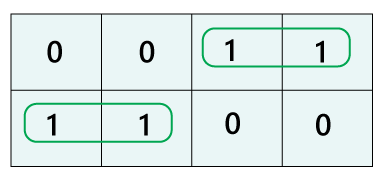
Notice that each group should have the largest number of ‘ones’. A group cannot contain an empty cell or cell that contains 0.

In a group, there is a total of 2n number of ones. Here, n=0, 1, 2, …n.
Example: 20=1, 21=2, 22=4, 23=8, or 24=16.

We group the number of ones in the decreasing order. First, we have to try to make the group of eight, then for four, after that two and lastly for 1.

In horizontally or vertically manner, the groups of ones are formed in shape of rectangle and square. We cannot perform the diagonal grouping in K-map.

The elements in one group can also be used in different groups only when the size of the group is increased.

The elements located at the edges of the table are considered to be adjacent. So, we can group these elements.
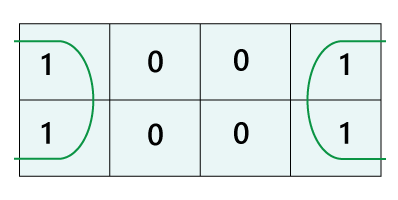
We can consider the ‘don’t care condition’ only when they aid in increasing the group-size. Otherwise, ‘don’t care’ elements are discarded.
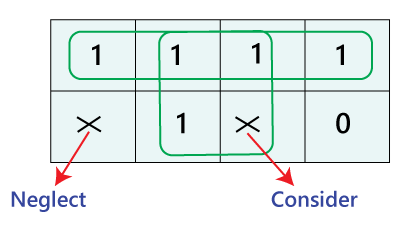
Step 4:
In the next step, we find the boolean expression for each group. By looking at the common variables in cell-labeling, we define the groups in terms of input variables. In the below example, there is a total of two groups, i.e., group 1 and group 2, with two and one number of ‘ones’.
In the first group, the ones are present in the row for which the value of A is 0. Thus, they contain the complement of variable A. Remaining two ‘ones’ are present in adjacent columns. In these columns, only B term in common is the product term corresponding to the group as A’B. Just like group 1, in group 2, the one’s are present in a row for which the value of A is 1. So, the corresponding variables of this column are B’C’. The overall product term of this group is AB’C’.
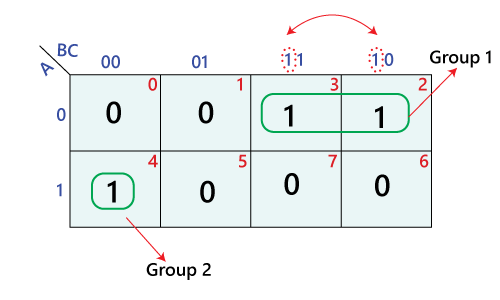
Step 5:
Lastly, we find the boolean expression for the Output. To find the simplified boolean expression in the SOP form, we combine the product-terms of all individual groups. So the simplified expression of the above k-map is as follows:
Let’s take some examples of 2-variable, 3-variable, 4-variable, and 5-variable K-map examples.
Example 1: Y=A’B’ + A’B+AB
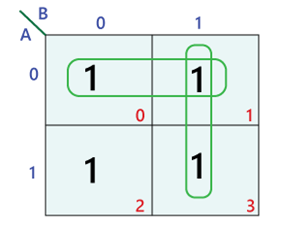
Simplified expression: Y=A’+B
Example 2: Y=A’B’C’+A’ BC’+AB’ C’+AB’ C+ABC’+ABC
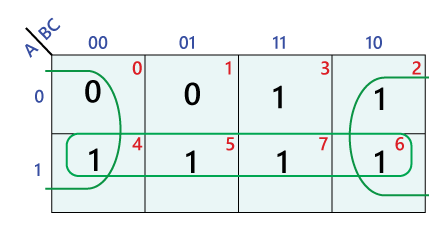
Simplified expression: Y=A+C’
Example 3: Y=A’B’C’ D’+A’ B’ CD’+A’ BCD’+A’ BCD+AB’ C’ D’+ABCD’+ABCD

Simplified expression: Y=BD+B’D’
Maxterm Solution of K-Map
To find the simplified maxterm solution using K-map is the same as to find for the minterm solution. There are some minor changes in the maxterm solution, which are as follows:
- We will populate the K-map by entering the value of 0 to each sum-term into the K-map cell and fill the remaining cells with one’s.
- We will make the groups of ‘zeros’ not for ‘ones’.
- Now, we will define the boolean expressions for each group as sum-terms.
- At last, to find the simplified boolean expression in the POS form, we will combine the sum-terms of all individual groups.
Let’s take some example of 2-variable, 3-variable, 4-variable and 5-variable K-map examples
Example 1: Y=(A’+B’)+(A’+B)+(A+B)
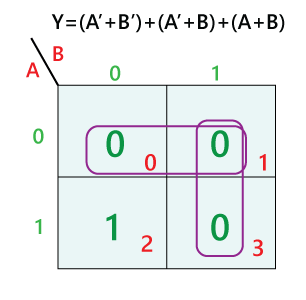
Simplified expression: A’B
Example 2: Y=(A + B + C’) + (A + B’ + C’) + (A’ + B’ + C) + (A’ + B’ + C’)
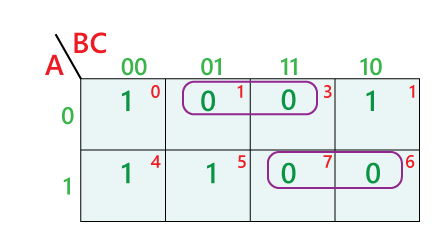
Simplified expression: Y=(A + C’) .(A’ + B’)
Example 3: F(A,B,C,D)=π(3,5,7,8,10,11,12,13)

Simplified expression: Y=(A + C’) .(A’ + B’)
